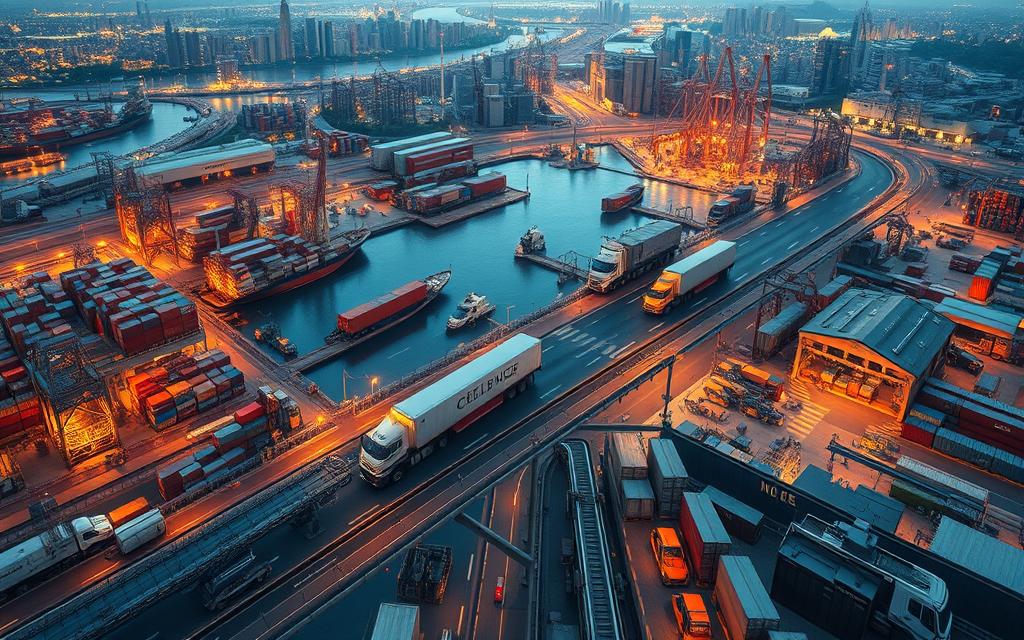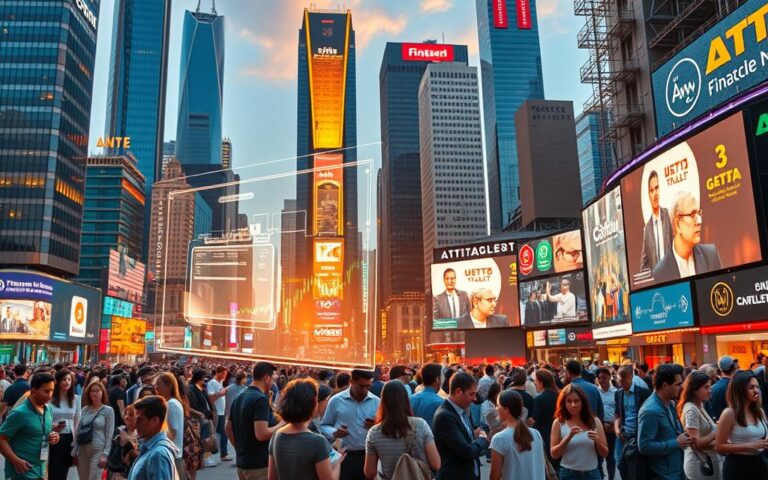Remember when the grocery shelves were empty? Or when your new phone’s arrival was delayed for months? These annoyances reveal a larger system. This system impacts nearly every buy in the U.S.
So, what’s a supply chain? It’s the steps from getting raw materials to bringing finished goods to you. A clear definition shows why delays cause higher prices, limited choices, and slower online orders.
Related content:
You will stay on the same website.
The impact is huge. The U.S. Census shows imports and exports drive the economy. Plus, millions work in supply chain roles, says the Bureau of Labor Statistics. These networks are key for moving groceries, electronics, cars, and health supplies.
Recent events show how important yet fragile supply chains are. COVID-19, the Suez Canal blockage, and chip shortages all caused issues. These incidents teach us that efficient supply chains are vital for everyone.
This article is more than just terms. It’s a guide on supply chain basics, key players, daily operations, tech’s role, and future trends. It helps leaders, policymakers, and shoppers understand how supply chains affect us all.
What is a Supply Chain?

A simple way to understand a supply chain is by seeing how everyday items get to us. The Council of Supply Chain Management Professionals explains it as a complex network. This network includes organizations, people, activities, info and resources. Together, they move a product from the supplier to the customer. Harvard Business Review sees it as both a strategic and operational system. This system controls how goods are distributed across different areas and platforms.
Definition of a Supply Chain
When we ask what a supply chain is, here’s a straightforward answer. It’s every step from raw materials to the final buyer. These steps include getting materials, making products, storing them, transporting, and then delivery. The process also involves planning, buying materials, making products, and fulfilling orders.
Key Components of Supply Chains
Supply chains have some main parts. These include suppliers, manufacturers, warehouses, and distribution centers. Plus, carriers that move goods in different ways. Wholesalers and retailers then connect products with customers. Lastly, the end consumers finish the product’s journey.
There are also important supporting tasks. Getting materials is procurement’s job. Managing stock versus demand is inventory management. Order fulfillment finishes the sales. Predicting demand guides production. Quality control keeps the brand’s reputation strong. And, reverse logistics takes care of returns and recycling.
Importance in Modern Business
Good supply chain management impacts cost, cash flow, and making customers happy. Being efficient helps products reach the market faster and gives a competitive edge. Apple shows how to operate on a large scale with coordination. Toyota uses a Just-In-Time system for less inventory and perfect timing. Amazon’s delivery network is fast and vast.
When supply chain management is poor, products run out, costs go up, and reputation suffers. Viewing the chain as both important in strategy and operation helps. This approach helps businesses design strong networks. Such networks reach across both place and digital spaces.
The Evolution of Supply Chains
The journey of commerce has seen how we move, control, and track goods change. It moved from local crafts to global industries. This part will cover major steps, tech advances, and how globalization changed supply chains today.
Historical Development
In the beginning, local artisans and markets dominated trade. Then, the Industrial Revolution brought mass production and factories. In the 1950s, McLean’s idea for container shipping cut costs and made long trade reliable.
By the 1980s, the focus shifted to logistics and efficient flows. Toyota led the way in lean manufacturing, improving efficiency and partnerships. From there, global production grew, leading to today’s complex international supply chains.
Technological Advancements
Enterprise systems from SAP and Oracle mixed different business areas like finance and production. Barcodes and RFID tags made keeping track of inventory better. GPS let shippers watch their goods move in real time.
Automation in warehouses and new digital platforms increased efficiency. Solutions from companies like Manhattan Associates showed the power of integrated networks. These innovations gave companies better control and faster reactions.
Globalization Impact
Open trade and agreements made it easier to work with Asia and Latin America. This made products cheaper and more varied but also added complexity. Timing became a bigger challenge for many companies.
Risks and costs in some areas made companies reconsider their locations. The tech industry shows this trend, with firms like Foxconn and Samsung creating global networks but also changing sourcing strategies for better risk management and quicker market entry.
Globalization still influences how companies pick suppliers, manage stock, and plan their shipping strategies.
Major Players in Supply Chains
Different actors work together in supply chains to move items from raw materials to finished products on shelves. Each one adds unique skills that affect cost, speed, and how reliable the market is.
Raw Inputs and Manufacturing Roles
Suppliers and manufacturers are crucial for making products. Suppliers give materials like metals, plastics, and parts used in making goods. Companies like BASF, Intel, and car makers such as General Motors and Ford rely on these materials to make their products.
The level of supplier is important. Tier 1 suppliers work directly with manufacturers. Lower-tier suppliers give parts to Tier 1 companies. If a few suppliers control key parts, this creates a big risk for disruptions.
Distribution Channels to Consumers
Distributors and retailers connect products to buyers. Companies like Sysco move large quantities to local markets. Stores like Walmart and Target use their size and locations to distribute products efficiently.
Amazon works as a distributor and retailer, changing how the supply chain operates. Retailers decide on product types, delivery speed, and what they require from suppliers.
Transportation, Warehousing, and Logistics
Logistics companies manage the movement and storage of goods. 3PL and 4PL firms offer services like warehousing and shipping. Big names in logistics like DHL and FedEx handle international shipping, customs, and local delivery.
They might manage large shipments or oversee complex online orders. How well logistics companies work impacts how long things take to ship and storage costs.
Collaboration and Power Dynamics
The relationships between suppliers, retailers, and logistics firms set the supply chain’s rules. Big retailers, such as Walmart, can dictate terms and quality. Amazon changes expectations with its fast shipping and return policies.
When manufacturers work closely with logistics firms, they can move things faster or more cheaply. These partnerships shift the value and profits within the supply chain.
Interactions and Impact on Performance
The supply chain works well when everyone shares info and coordinates their actions. If suppliers and manufacturers keep quality consistent, retailers can keep less stock. Efficient logistics mean lower costs per item.
But if there’s a problem in manufacturing or a delay in shipping, it affects the whole supply chain. Everyone’s reliability impacts costs, speed, and how happy customers are.
How Supply Chains Operate
Supply chains help turn raw materials into finished products you can use. They include steps like getting materials, making goods, and delivering them. Everything needs to work together smoothly to avoid delays and save money.
Procurement Process
Finding supplies starts with choosing the right strategy. Companies might pick one supplier for better quality or several to reduce risks. They think about cost, quality, and how dependable suppliers are. A deal is made to set delivery times and what happens if targets are missed.
Keeping a good relationship with suppliers is key. Companies use online platforms like Coupa and SAP Ariba to manage orders. Best practices include checking how money is spent, rating suppliers, and talking about new deals often.
Production Workflow
The production part involves designing, building, checking quality, and packaging. Look at how cars are made; they are put together step by step. Electronics companies do similar things with circuits and final products.
Tools like MRP and JIT help make sure enough products are made. MRP figures out what materials are needed. JIT keeps inventory low by getting parts just in time. Quality checks and testing make sure products are good to go.
Distribution Methods
Goods are moved by trucks, trains, planes, and ships. Shipping containers can go by sea, then rail or truck. Small packages might go through fast delivery networks.
There are central warehouses for storing a lot of products and regional ones to deliver fast. Shipping directly to customers or using suppliers are different ways to fulfill orders. The last part of delivery can be the trickiest and most expensive.
Successful operations are tracked with important measures. Teams look at how long things take, stock levels, and if deliveries are on time. They use dashboards for a clear view of what’s happening.
Working together in buying, making, and shipping means less waste. When everyone has up-to-date info, products move faster. A unified supply chain helps keep everything flowing smoothly, from start to finish.
| Stage | Typical Tools | Key Metrics | Real-World Example |
|---|---|---|---|
| Procurement | e-Procurement (Coupa, SAP Ariba), Supplier Scorecards | Cost per unit, Supplier On-Time Rate | Ford sources stamped parts, balances single and multiple suppliers |
| Production | MRP, JIT systems, MES (Manufacturing Execution Systems) | Cycle Time, Yield Rate, Inventory Turnover | Toyota uses JIT on assembly lines to reduce inventory |
| Distribution | WMS (Warehouse Management Systems), TMS (Transport Management Systems) | Order-to-Delivery Time, Fill Rate, On-Time Performance | UPS and Maersk use intermodal links for global moves |
The Role of Technology in Supply Chains
Technology has changed the way goods are delivered to our doors. It makes decisions quicker, improves coordination, and offers better insight. By connecting systems, teams can use the best methods to reduce waste and deliver faster.
Warehouse and Production Automation
Automation is key in today’s warehouses and factories. For example, Amazon uses Kiva robots to boost efficiency. Robots by ABB and FANUC handle the same tasks over and over with great accuracy.
Robots also carry goods across warehouse floors without stopping. This lowers labor costs, increases accuracy, and makes workplaces safer. These improvements help with keeping less stock and reducing the time it takes to deliver products.
Core Supply Chain Systems
Software is crucial for tying all operations together. Systems by SAP and Oracle oversee finances, ordering, and making goods. Systems for managing transportation and warehouses coordinate shipping and stocking.
Tools like Blue Yonder and Kinaxis offer advanced planning and quick adjustments. Using these tools together allows for complete visibility, easier order management, and faster procurement, which leads to quicker delivery times.
Data Analytics and Intelligent Tools
Data tools turn numbers into plans. They use AI to avoid too much or too little stock and to schedule the best delivery routes. They help save fuel and ensure deliveries are on time.
Programs like Tableau and Power BI show trends clearly. They’re used for keeping machines running smoothly and setting prices smartly. They also spot problems early, so teams can react swiftly.
Security and Governance
As systems connect more, keeping data safe and well-managed is crucial. Firms need to secure info while still analyzing it effectively. Strong management ensures models are accurate and helps digital changes succeed.
Enabling Better Practices
Tech supports the best supply chain methods when used right. It leads to clear communication, quick decisions, and flexibility. This helps companies meet needs, lower costs, and adjust to new situations confidently.
Benefits of Efficient Supply Chains
Efficient supply chains help companies in many areas. They control costs better, deliver faster, and become more competitive. Let’s look at how investing in supply chain excellence really pays off.
Cost Reduction
Keeping inventory at the right level saves money and frees up capital. Using smart shipping methods and working well with suppliers cuts freight costs and waste. This helps companies spend less on storage and stock.
Toyota and Amazon have saved money by cutting waste and scaling logistics. Key measures for saving money include cost per unit and how long inventory lasts.
Improved Customer Service
Good forecasts and quick shipping mean products arrive on time. Keeping customers informed and deliveries reliable builds trust and repeat business. Happy customers often lead to high satisfaction scores and strong loyalty.
Amazon and Zappos are known for fast and dependable service. Companies that match this level of service lower return rates, keep more customers, and build their brand.
Enhanced Competitiveness
Flexible supply chains make it easier to launch new products quickly and adjust prices. Being quick to market and adapt allows companies to use trends for growth. Zara’s success with fast fashion highlights how a sharp supply chain strategy can boost sales.
Important measures of competitiveness include fill rate, cycle time, and loyalty scores. Improving processes and systems lowers costs and makes companies more competitive in pricing and responsiveness.
- Cost per unit — measures production and delivery efficiency.
- Fill rate — gauges ability to meet demand from stock.
- Customer satisfaction scores (CSAT) — reflects service quality.
- Net Promoter Score (NPS) — signals loyalty and advocacy.
- Inventory days of supply — indicates capital tied in inventory.
Using best practices in supply chain management helps in cutting costs soon and gaining long-term benefits. Keeping an eye on the right KPIs shows the value of these investments.
Challenges Facing Supply Chains
Supply chains worldwide are feeling the heat from many sides. Companies have to deal with disruptions, follow strict rules, and work towards being more eco-friendly. Making the supply chain strong is now crucial for a company’s survival.
Disruptions and Risks
Natural disasters, health crises, strikes, and political unrest cause sudden problems. Issues like chip shortages have shown the big impact of relying on one source. This was clear when Ford and General Motors faced difficulties. When the Port of Los Angeles got clogged in 2021, it led to delays and higher costs for many.
Cyberattacks can stop manufacturing lines. Relying on one supplier is risky. To lessen this risk, companies use more than one supplier, keep extra stock, and plan for different scenarios.
Regulatory Compliance
Dealing with trade laws and customs forms makes global trade complicated. Companies have to be careful with export rules like ITAR and EAR. Those in food and drugs must follow FDA guidelines. If companies don’t comply, they could face big fines and have their shipments stopped.
To keep up with rules, firms are using software to manage compliance. They also train their teams to avoid mistakes. This helps them stay in line with laws in different places.
Sustainability Issues
Companies now look closely at their environmental impact. They’re concerned about emissions from transport, waste from packaging, cutting down forests, and mining. Businesses are working to reduce their carbon emissions and follow EPA advice.
Programs like Science Based Targets encourage suppliers to do better. Companies are making their storage greener and checking their practices for risks. This effort is not just about the environment. It also makes the supply chain stronger and meets what people expect from businesses.
To handle these challenges, firms need a solid plan. This includes working together with governments and other companies, diversifying suppliers, and focusing on sustainability. This strategy helps ensure the supply chain stays strong.
Supply Chain Trends to Watch
Global commerce is changing quickly. We see new trends like changing buying habits and stricter rules for being green. Companies big and small, from Amazon to Walmart, are finding new ways to send goods. Meanwhile, brands like Unilever and IKEA focus on using less harm to the planet. All these changes are reshaping how things are bought and moved today.
E-commerce Influence
E-commerce is making big waves. The U.S. Census Bureau says online sales are going up. This makes businesses think about how to deliver goods fast to city dwellers.
Many retailers, including those on Shopify, Amazon, and Walmart, are working on getting items to customers faster. This includes same-day delivery and easy returns. Because of this, those who deliver and store goods are changing how they do things.
The Rise of Sustainability
People now prefer products that don’t hurt the environment. This has led companies to reduce pollution and use resources wisely. Giants like Unilever aim for zero emissions, and IKEA is focusing on less waste.
With the help of labels like Fair Trade, companies choose materials that are good for the planet. Innovations in packaging and cleaner transport are now crucial. This helps the supply chain support greener choices.
Digital Transformation
Thanks to technology, teams can use up-to-date information for better planning. With blockchain, like the IBM Food Trust, it’s easier to track goods and avoid scams.
Sensors and AI help keep goods fresh and make quick decisions. This helps make the supply chain more flexible and precise.
New rules and pressure from the market are speeding up these changes. They will change how we get products, meet customer expectations, and work with partners for faster, greener service.
The Impact of COVID-19 on Supply Chains
The pandemic changed how we move goods globally. Companies struggled with unexpected problems, showing weaknesses in their systems. This part talks about the immediate impacts, the major changes that came after, and how businesses made their supply chains stronger.
Initial Disruptions
In early 2020, factories in China and parts of Europe stopped working. This stoppage broke the production of important parts. Ports couldn’t handle the traffic, causing delays. And labor shortages hit warehousing and trucking hard due to sickness and lockdowns.
Customers found basic items like toilet paper and canned food missing from shelves. Health systems ran low on protective gear and some medicines, revealing flaws in the supply chain.
Long-Term Changes
Businesses began keeping more stock on hand and planning for longer disruptions. They started thinking more about where they get their supplies and began using more local suppliers. They also invested more in machines to do simple, repeatable work.
The shortage of semiconductors didn’t end with the pandemic’s early days. This problem hurt car and tech companies badly. It led to new government policies and made companies focus more on predicting and managing their supply chains.
Resilience Strategies
Companies looked at bringing production closer to home and diversifying their suppliers to countries like Vietnam, Mexico, and India. The U.S. government passed the CHIPS Act to boost local production of semiconductors. This shows how policies can help make industries stronger.
Businesses also started using tools to keep a better eye on their supplies, ran tests to handle stress better, and worked more closely with their most important suppliers. Governments stocked up on crucial supplies and worked out how to manage trade and logistics better. These actions teach us an important lesson: being resilient means being ready to adapt and plan for many different futures.
| Challenge | Immediate Effect | Common Response |
|---|---|---|
| Factory shutdowns | Production halts, component shortages | Multi-sourcing and regional suppliers |
| Container and port congestion | Delayed shipments, higher freight costs | Inventory buffering and route diversification |
| Labor shortages | Reduced warehouse throughput | Automation and workforce reskilling |
| Semiconductor scarcity | Long lead times for electronics and autos | Policy support like the CHIPS Act; domestic capacity |
| Supply visibility gaps | Inability to predict disruptions | Investment in digital visibility and analytics |
The Relationship Between Supply Chains and Consumers
Consumers experience supply chains through daily choices. What we see on store shelves, delivery times, and product details all come from earlier decisions. This part explains how those decisions impact what’s available, our trust, and our expectations.
How lead times shape what shoppers find
Lead times and how things are stored and moved decide if items are available. Seasonal items like coats may sell out if a cold wave is unexpected. Electronics might be short if there aren’t enough parts or if shipping is slow.
Retailers like Best Buy and Target change their stock rules to avoid empty shelves. These examples show us how planning affects what we see online and in stores.
Provenance and traceability
Nowadays, people want to know where their purchases come from. They ask about where it’s made, how workers are treated, and its environmental impact. Brands answer by making their supply chains clear.
Walmart’s tests with IBM Food Trust prove how blockchain can trace food’s journey. Patagonia’s website shares where and how their products are made. Showing this info builds trust.
What buyers expect from modern commerce
Shoppers’ needs make companies aim for faster and better service. Amazon’s quick shipping has become a standard to match. People expect quick deliveries, simple returns, reliable stock, and responsible sources.
Labels like Fair Trade and Organic respond to demands for trustworthy products. Sharing details online helps buyers trust and choose what to buy.
How buying choices steer corporate practice
Shopping choices can change how companies act. If buyers prefer eco-friendly products, companies will adapt their sources and materials. Calls for change or boycotts can accelerate these changes.
Putting money into more warehouses, having backup sources, and better online tracking shows the value of being resilient. These actions lower risks and ensure things stay in stock for shoppers.
| Consumer Concern | Supply Chain Response | Supply Chain Examples |
|---|---|---|
| Out-of-stock items | Increase safety stock, improve forecasting | Target’s inventory rules; Best Buy launch allocations |
| Provenance and ethics | Publish supplier lists, use traceability tech | Patagonia disclosures; IBM Food Trust pilots at Walmart |
| Fast delivery and returns | Expand fulfillment centers, optimize routes | Amazon two-day standard; UPS and FedEx network optimization |
| Verified quality | Adopt certifications and third-party audits | Fair Trade coffee sourcing; USDA Organic labeling |
Case Studies: Successful Supply Chain Strategies
Real-world cases show how companies make their supply chains better and faster. Stories from Toyota, Tesla, Sysco, Walmart, Kroger, Amazon, and Zara teach valuable lessons. They offer steps for others to try in their operations.
Example from the Automotive Industry
Toyota’s approach is a leading example in automotive supply chains. It focuses on lean production and working closely with suppliers. The company boosts efficiency with just-in-time processes, continuous improvement, and identifying weak supplier links quickly.
Toyota quickly bounced back from the 2011 Tohoku earthquake. They did this by having a clear view of their suppliers and ready recovery plans. This strategy reduced downtime and production loss significantly.
During the chip shortage, Tesla stayed ahead by tweaking its software and redoing supply deals. These moves helped Tesla keep making cars while others stopped. Tesla’s strategy offers insights into managing risks and keeping supply chains adaptable.
Lessons from the Food Industry
Big companies like Sysco, Kroger, and Walmart focus on keeping foods fresh and safe. They use strict cold-chain measures, such as temperature checks, sealed packages, and efficient routing. These steps cut waste and keep food quality high.
Walmart’s blockchain project for tracking produce slashed tracking time to just seconds. This speed is vital for managing recalls and gaining customer confidence. Lessons from the food sector underline the importance of swift action and clear tracking.
Innovations in Retail
Amazon changes the game with its quick fulfillment centers, use of robots, and Prime service. The blend of tech and a strong local presence meets customer needs fast.
Zara keeps up with fashion trends through close ties with its suppliers and making some items itself. This strategy lets Zara get new styles out swiftly. Both Amazon and Zara highlight the benefits of omnichannel strategies and Buy Online, Pick Up In Store (BOPIS) for pleasing customers.
Practical takeaways
- Supplier collaboration reduces surprises and strengthens flow.
- Investment in visibility tools speeds response and supports traceability.
- Flexible manufacturing and agile contracts ease material shortages.
- Customer-centric fulfillment, including BOPIS and micro-fulfillment, improves service levels.
Future of Supply Chains
The next ten years will change how we send and receive goods. McKinsey, Deloitte, and the World Economic Forum believe manufacturing will move closer to home. They also say logistics will use more green energy and warehouses will become automated. Their 2030 outlook includes fleets of electric and hydrogen trucks, and stricter rules to avoid disruptions.
AI will lead this transformation. It will make demand forecasts better and freight vehicles autonomous. AI will also enhance route planning and make sourcing more dynamic. Companies like Siemens, IBM, and Amazon are testing new tech. They’re exploring how to spot issues in real time and use robots in warehouses. This shows digital shifts can make choices faster and cost less.
What people want will shape supply chains’ future. Keeping up means offering unique products, being open about eco-friendliness, delivering faster, and making returns easy. Supply chains need to be flexible, use the latest data, and have strong partners for quick changes and tracking.
Changes in policies and jobs will also occur. Firms need to train their people in logistics and data analysis. They must also get ready for new laws about cutting carbon and keeping track of goods digitally. To succeed by 2030, companies should focus on clear supply chains, have many suppliers, test AI, automate, and think green and customer-first.



